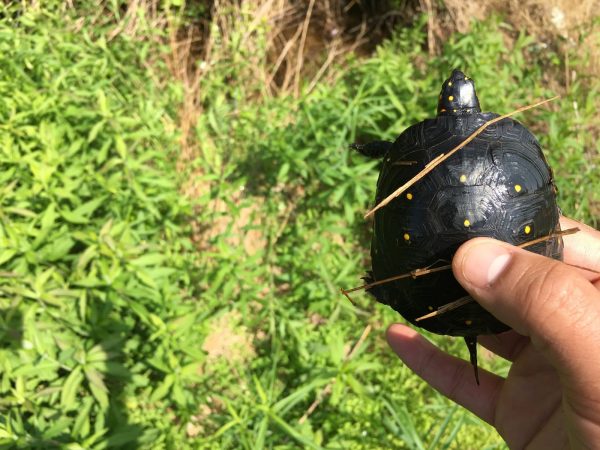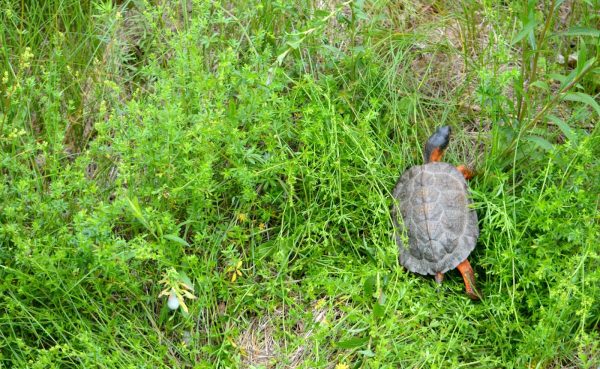Two native species of the turtle variety that are often found around or within wetlands.
Wetlands come in a variety of types. Some are found along the coast, such as tidal marshes, while others can be found isolated along mountain ranges, such as vernal pools. Pennsylvania is rich with a variety of wetland types, along with a suite of native species that are very much reliant upon them. On World Wetlands Day, I’d like to highlight two native species of the turtle variety that are often found around or within wetlands, starting with a tiny but spectacular species belonging to the Clemmys genus:
Spotted Turtle (Clemmys guttata)
Spotted Turtles (Clemmys guttata) are among the most recognizable but infrequently seen turtle species we have in Pennsylvania. They’re easy to recognize because they’re the only turtle species to sport bright yellow spots on their carapace. However, they’re seldom seen by most folks because 1) they’re extremely shy and will readily dip into the water if they see people approaching, 2) they’re one of North America’s tiniest turtles, maxing out at around 4.5 inches in length, and 3) they’re mostly active for short windows of time during early spring and early fall.

As is indicated from their inclusion in this article, Spotted Turtles are closely tied to wetlands and inhabit varying types; they’re known to inhabit bogs, swamps, vernal pools, and will occasionally venture into the floodplains of creeks. Unfortunately, Spotted Turtles are considered a species of special concern in Pennsylvania due in part to their reliance on wetlands throughout the year. Many of the places they call home have been or currently are being sacrificed for the sake of suburban sprawl. To compound the effects of habitat loss and fragmentation, the need for females to leave wetlands in order to lay eggs leaves them susceptible to road mortality. Luckily, there are biologists in the state who are beginning to monitor populations of Spotted Turtles, which is the first step in conserving what is easily one of our most beautiful reptile species.
Wood Turtle (Glyptemys insculpta)
Another striking and aptly named turtle species is the Wood Turtle (Glyptemys insculpta). They get their name from the intricate pattern found on their shell which resembles engraved wood. This species is much larger than the Spotted Turtle, maxing out at around 9 inches in length, but relative to some of the giants (snappers, softshells, etc.) Wood Turtles are considered a medium-sized turtle species. Wood Turtles aren’t as closely tied to wetlands as some of our other turtle species, as they are more often found within creeks and streams. However, they spend a considerable amount of time within floodplains and are often found foraging within bogs.

Similar to the Spotted Turtle, and for many of the same reasons, Wood Turtles are listed as a species of special concern in Pennsylvania. Because Wood Turtles occupy both aquatic and terrestrial habitats depending on the time of the year, they’re susceptible to multiple forms of habitat loss and road mortality. Luckily there are biologists actively working to monitor populations of this species, but until the places they call home are preserved, their numbers are likely to continue declining. This has been the case for their closest relative, the Bog Turtle (Glyptemys muhlenbergii), which is a federally threatened species and is endangered in Pennsylvania. Collectively, Spotted, Wood, and Bog turtles make up an entire clade on the evolutionary tree of turtle diversity. This further drives home the importance of protecting wetlands, as we stand to lose large components of our natural history if we don’t.
We’re lucky to have wetlands scattered throughout the commonwealth, but as we continue to expand our neighborhoods, many are being erased from the landscape along with the creatures that evolved to live within them. One of the best ways to protect wetlands is to give to local land trusts who are actively acquiring and preserving land in perpetuity. It’s also worthwhile to donate to the various groups that are monitoring populations of declining wetland species. This article touched on two such species, but there’s an assortment of plants and animals that could also use help.
Consider stopping by a local wetland to take in the life that they support. And who knows, maybe you’ll come across an interesting turtle in the process.
Thanks for reading!
Sebastian Harris, Conservation Easement Steward.
